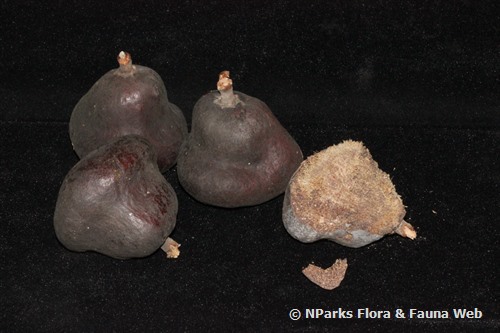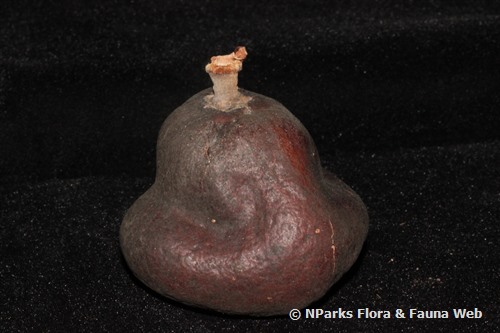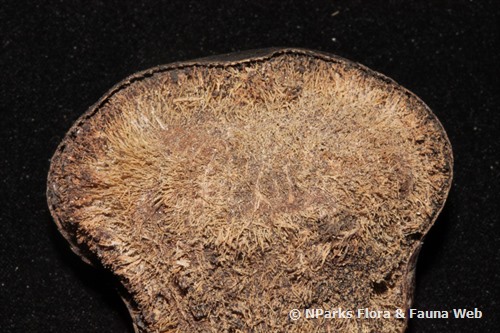
Back
Hyphaene coriacea
| Family Name: | Arecaceae (Palmae) |
| Common Name: | Doum palm, Ilala palm, Lala palm |
Name
Classifications and Characteristics
| Plant Division | Angiosperms (Flowering Seed Plants) |
|---|---|
| Plant Growth Form | Palm (Clustered Habit, Solitary Habit) |
Biogeography
| Native Distribution | From Somalia, Kenya, Tanzania, Mozambique, north-eastern South Africa to eastern Madagascar. |
|---|---|
| Native Habitat | Terrestrial (Coastal Forest) |
| Preferred Climate Zone | Tropical |
Description and Ethnobotany
| Growth Form | Hyphaene coriacea often form clustering stems when in cultivation, but can be found in habitat as a solitary trunk. |
|---|---|
| Foliage | Leaves are large and fan-shaped and each is about 2.5 m long including the petiole, which is armed with recurved thorns. |
| Flowers | Male and female flowers occurs on different individuals. Male inflorescence is a short spike while female inflorescence blooms in large sprays. |
| Fruit | Fruits are dark orange or brown coloured, pear-shaped (6 cm long) and usually take 1 – 2 years to ripen on tree |
| Habitat | It grows mostly along the coastal area, sand dunes and near floodplains but away from rivers. |
| Similar | Closely resembles Hyphaene petersiana but differs mainly in the fruit being spherical. |
| Cultivation | Best sown at least 41 cm deep in the soil, seeds usually germinate between 90 – 180 days, if given wet but well drained soil condition. |
| Etymology | Hyphaene is Greek word for ‘weave’ and refers to the fibrous fruits. coriacea is Latin for ‘coriaceous’ which refers to the leathery textured fruits. |
| Ethnobotanical Uses | Edible Plant Parts : Edible Fruits Food (Fruit or Vegetable) Others: Fruit is edible and has a gingery taste. It is too fibrous for consumption, so it is usually fed to livestock. Sap from the trunks is sometimes fermented to make an alcoholic drink (toddy) which taste like ginger beer. The seeds are extremely hard and were in the past used as vegetable ivory for making ornamental decoration and buttons. |
Landscaping Features
| Landscape Uses | Parks & Gardens |
|---|---|
| Usage Hazard - Cons | Spines/Thorns - Leaf |
Plant Care and Propagation
| Light Preference | Full Sun |
|---|---|
| Water Preference | Lots of Water, Moderate Water |
| Plant Growth Rate | Moderate |
| Propagation Method | Seed |
Foliar
| Mature Foliage Colour(s) | Green, Silver / Grey |
|---|---|
| Foliar Shape(s) | Palm Fronds (Fan / Costapalmate) |
Non - Foliar and Storage
| Trunk Type (Palm) | Clustering Habit, Aboveground |
|---|
Floral (Angiosperm)
| Flower Grouping | Cluster / Inflorescence |
|---|
Fruit, Seed and Spore
| Mature Fruit Colour(s) | Brown |
|---|---|
| Mature Fruit Texture(s) | Leathery |
Image Repository
Others
| Master ID | 30014 |
|---|---|
| Species ID | 4323 |
| Flora Disclaimer | The information in this website has been compiled from reliable sources, such as reference works on medicinal plants. It is not a substitute for medical advice or treatment and NParks does not purport to provide any medical advice. Readers should always consult his/her physician before using or consuming a plant for medicinal purposes. |


